Three flags blow in the wind in Ushuaia, the world's southernmost city, located 3,200 kilometres from Buenos Aires, where this Sunday the second edition of the BienalSur art fair kicked off.
The event is part of Argentina's largest artistic and cultural event focused solely on contemporary art.
La Bienal, as it is known, will visit 110 venues in 43 cities in 20 countries. Four hundred artists are involved in the fair.
On the middle flag, the artistry of Frenchman Christian Boltanski bearing the word "Utopia". To one side of the central flag post at the Aeroclub Ushuaia are flags by Chile's Voluspa Jarpa and Argentina's Magdalena Jitrik. In the distance, the view of a snow-covered mountains behind the Beagle Channel.
Nearby, event goers listen to a moving quechua prayer interpreted by the Native Instrument and New Technologies Orchestra of the Tres de Febrero National University (UNTREF).
The "flags of the end of the world" are part of a project tied to "Draw me a flag", an idea conceptualised by Boltanski for the Cartier Foundation of Paris, which to date comprises of 95 flags produced by artists from across the world. Some are being shown in Buenos Aires and Río de Janeiro as part of the BienalSur.
The event's opening in Ushuaia featured the mastery of the quechua community of Lucía Toconas - or Kanchay Goyllur, as it is known in the quechua language - from the distant hills of Jujuy province, in the country's far north.
'SOUTH OF THE SOUTH'
The decision to hold the event in Ushuaia was not a random one.
"It's the south of the south. This is about changing the currents of culture", said Aníbal Jozami, director general of the Bienal and Dean of UNTREF.
The Bienal will travel 19,000 kilometres by the time of its closure in Octubre. Its base is Buenos Aires, where events will be held between June 22 and 29, while Tokyo is the farthest city on its itinerary of international destinations.
"In a world that builds walls, BienalSur builds processes of integration. We try to erase borders: respecting differences, we knock down walls", Jozami told AFP.
The first day of the event in Ushuaia featured a series of opening. Two museums here share the same name, that of el Fin del Mundo ("The End of the World"): one is the Natural Science museum in the former Banco Nación headquarters; and the other, a museum located in the old Government House.
An original copy of a diary once belonging to Charles Darwin is kept at the old Banco Central, where biologist and artist Pablo La Padula is presenting his work La mirada que construye al mundo ("The viewpoint constructed on the world"), a huge collage of documentary images made by scientists, starting with Aristotle.
In the other museum with the same name, visitors can find the exhibit Arte y Territorio ("Art and Territory") which brings together the artistic videos made by the Brazilian Anna Bella Geiger; German artist Harun Farocki; the French artists Zineb Sedira and Jean-Christophe Norman; and the Canadian Kapwani Kiwanga, whose collections are part of the FRACS-Regional Collections of Contemporary Art in France.
LAS MALVINAS
In this southern province, whose complete name is Tierra del Fuego, Antártida e Islas del Atlántico Sur (Land of Fire, Antarctica and Islands of the South Atlantic), it is impossible to overlook the Malvinas Islands, which have been occupied by the United Kingdom since 1832 and over which Argentina maintains a claim to sovereignty.
In his work Dos, tres, muchas ("Two, Three, Many"), the artist Esteban Álvarez is encouraging interactions among those who pass through the Pensar Malvinas Museum to "appropriate" the islands in a symbolic way. Each viewer can make his or her own work by rubbing a piece of graphite over a surface representing the disputed archipelago.
The event will continue on Monday with three more openings in the Museo Fuegino de Art de Río Grande, located 200 kilometres north of Ushuaia, where Álvarez's work will be replicated.
Río Grande is on the coast and is known as the City of Vigils for the Malvinas, where every April 2 former soldiers of the 1982 war gather to commemorate Argentina's 649 fallen soldiers.
El agua que apaga el fuego ("The water that puts out the fire") is another work scheduled to be shown there. Created by artist Gustavo Groh, it uses photographs of the abandoned trenches along the border of Argentina and Chile where in 1978 the country's respective military dictatorship were close to going to war, again over territory.
Another, paisajes entre paisajes ("scenery among scenery") brings together videos of artists from Argentina, Brazil, Uruguay and Poland.
'CREATIVE CHAOS'
Despite the economic crisis facing Argentina and other participating countries, the second edition of BienalSur is larger that its first, which was held in 2017.
"This is a big effort but since they told us it wouldn't be possible, we did it", Jozami said, enthusiastic about a "unique project in the history of art in Argentina".
Despite there being no formally defined themes, many of the works on display question gender and territory, Diana Wechsler, the event's artistic director and curator, told AFP.
"We like to see creative chaos", she said.
By Liliana Samuel/AFP
(translated from Spanish to English by Times)













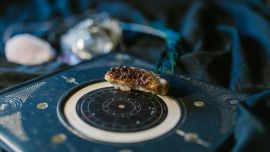
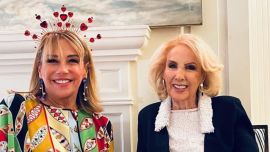


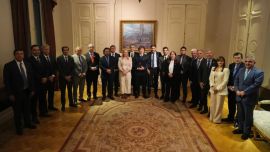
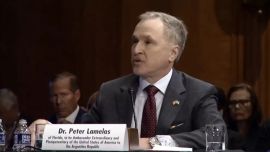

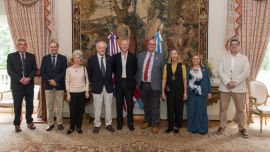





Comments